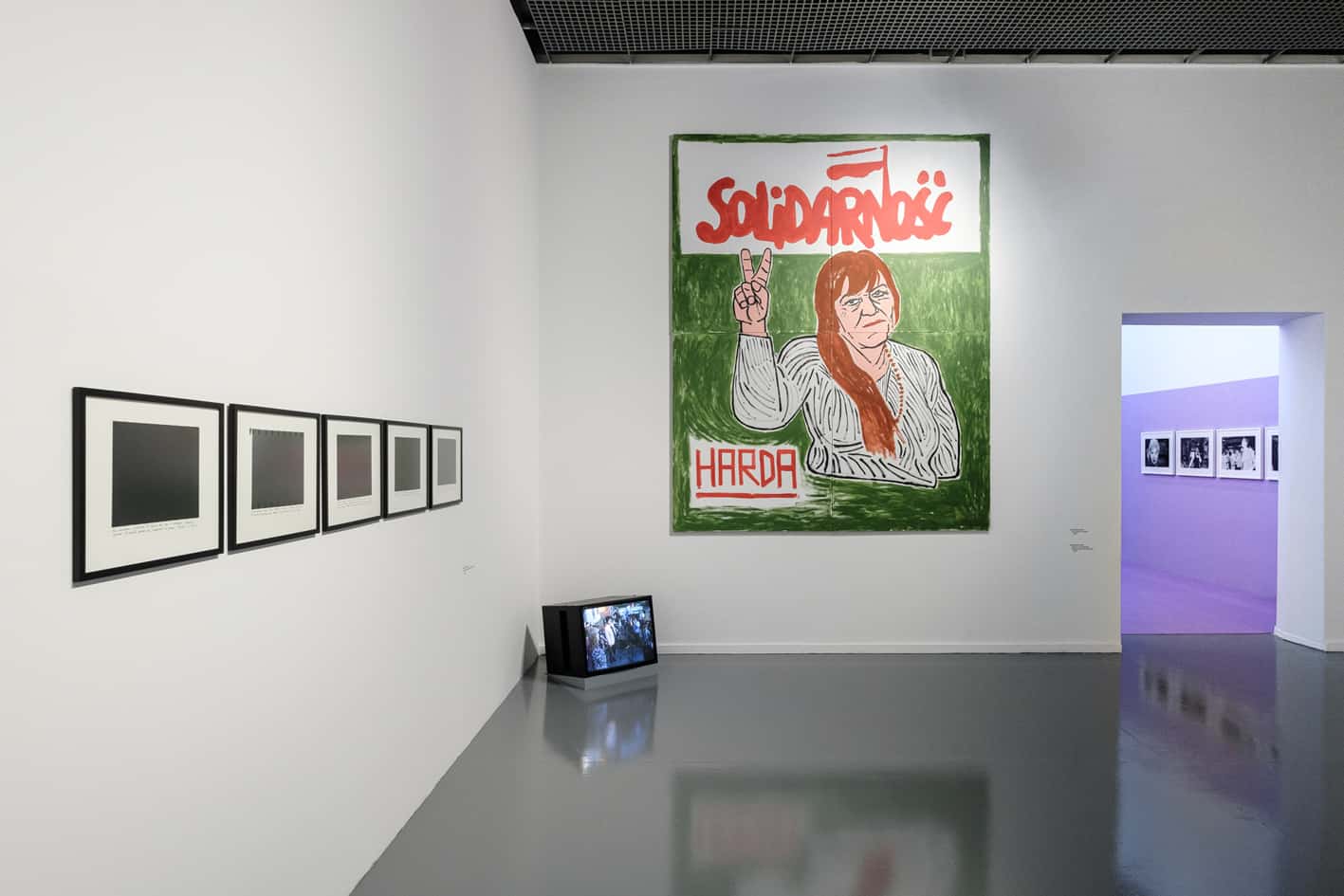Through “The Power of Secrets” exhibition, Karol Radziszewski presents himself as a multidimensional figure i.e. a curator, a collector, a painter and a friend to both male and female artists. The exhibition itself familiarizes visitors with all these parts Radziszewski plays. It provides the audience with an opportunity to take a peek at the “Queer Archives Institute” resources, and lets them understand personal experiences of this unconventional artist. Karol Radziszewski together with the curator of the exhibition, Michał Grzegorzek, invite us to take a walk through the archives and to admire their performance value. They help us understand how the queerness finds its way into our lives at virtually all stages, from the early childhood to death, at times when we feel lonely and those when we happily enjoy the companionship of our friends. In this conversation, the artist explains to Marta Czyż why there are so many motives and themes in The Power of Secrets.
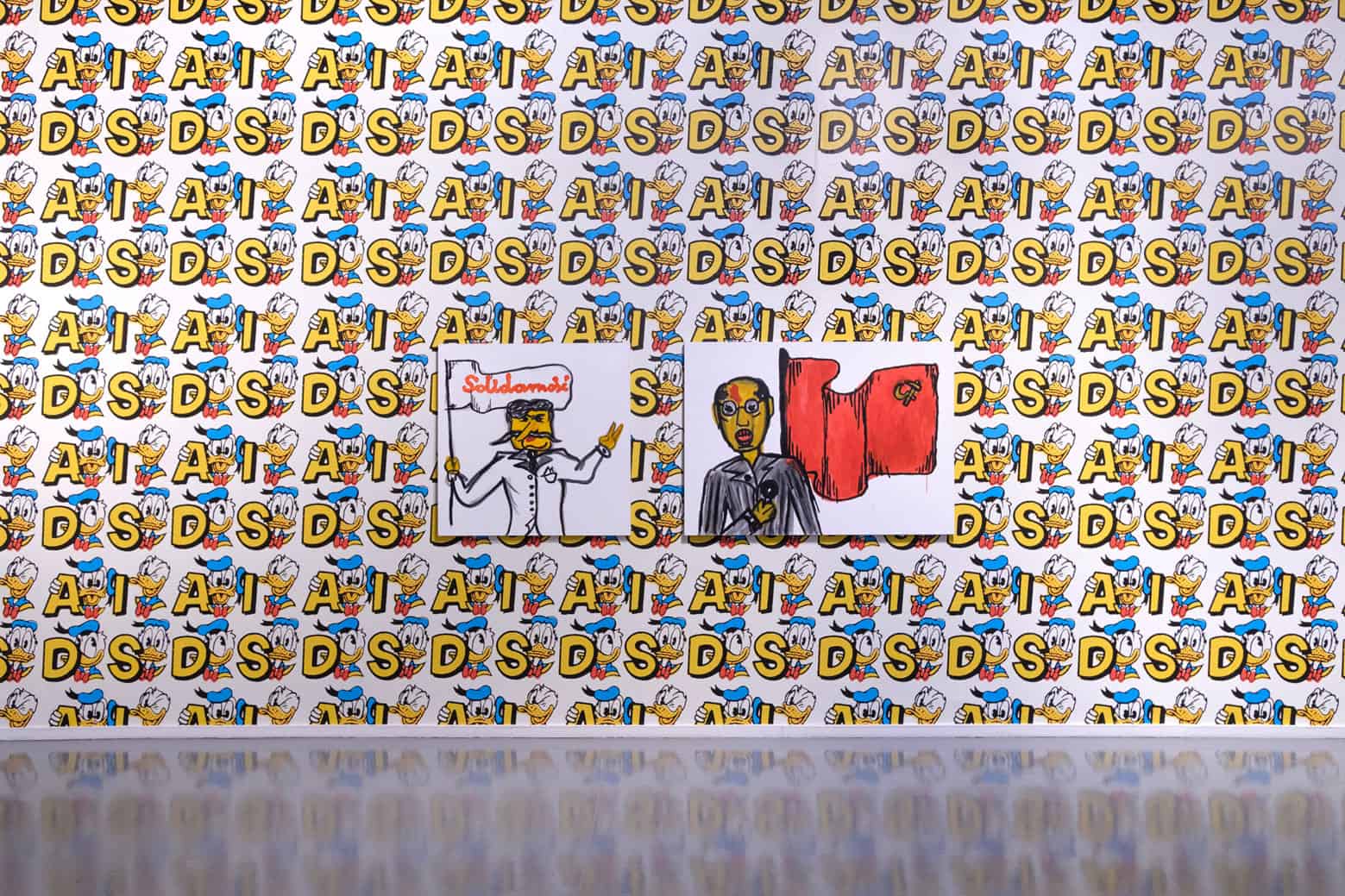
Karol Radziszewski, The Power of Secrets, exhibition view, 2020, photo by Bartosz Górka
Marta Czyż: Who are the protagonists you present at the exhibition?
Karol Radziszewski: There is an awful lot of them. My exhibition is, to a certain extent, an educational and historical project and its topic are people. However, it is not only important who I talk about, but also for whom the narration was created. When I worked on this exhibition, I was certainly thinking about the people who would see it in person.
MCz: Can you tell us precisely who this exhibition is about?
KR: I wanted the exhibition to work like layers of a decorated birthday cake. The first layer is very straightforward and colourful, but if one wishes, they can delve deeper into the nature of the presented issues. The underlying axis for this exhibition was the archive, my collection and recordings. The show is addressed both at people who are interested in the presented issues, who already are in these particular circles, but also at those who are not familiar with the topic at all. For them is the first opportunity to learn about people and stories that are part of Polish history and culture.
MCz: Tell me a bit more about these layers. Could you maybe elaborate on the princesses that we see just as we enter the exhibition space?
KR: The first room boasts huge, colourful murals featuring princesses. Everything is figurative and easily recognizable. This is the level where even young children can be entertained. Later comes the conclusion that every single one of us used to draw such figures sometime in the past. Men and women used to have a similar manner of drawing things, although the topics of those drawings may have differed significantly. Some visitors even send me their photographed drawings. They post them on Instagram and comment on how they went through this stage just as everyone else. The next layer is the archive of an artist which dates back to the late 1980s. What I did deliberately was present archival drawings on par with “proper” paintings, both on the walls and on canvas. Seemingly trivial motives presented with the use of high art medium evoke deeper thoughts and encourage analysis. As we go further, there is a symbolic, psychological or political layer and this is where we can decode these motives as a truly existing gender monster. In there, we only have our own imagination which is free from any external influence. It goes towards the queerness and perplexing idea of gender.

Karol Radziszewski, The Power of Secrets, exhibition view, 2020, photo by Bartosz Górka
MCz: This layer of your own story as an artist and your paintings is extremely interesting to me. You show us artworks that were preserved, but there was a stage in your work an important one, that didn’t survive. You also took a break in painting.
KR: A lot of my significant works burnt down when my workshop in Praga district in Warsaw went on fire in 2013. At that time, I worked mostly with videos and intangible art. I did not intend to go anywhere near the painting. Works which burnt down also functioned as reproductions. Their status is bizarre. Most of the documentation is still available, but even so, I decided not to reproduce too many of the burnt pieces.
All in all, only a very small number of them was redone. Besides, I was sure that the sketchbooks, which you can see at the exhibition, burnt down too. I was nine years old when I drew in them. I worked with them later, but after the fire I never expected to see them again. In 2008, I worked on a project entitled “Friends” with Kuba Dąbrowski. It was about comparing the passions of the young age around which lives of boys revolved. As two men were born roughly at the same time and in the same city, we were interested in what the works that we created in school and teenage years could tell about us. At that point in time, I brought the sketchbooks to Warsaw for the first time. As it turned out, I took them back to Białystok in the meantime and left them in my family home. Ever since my childhood, I have been keeping all my drawings, because I always wanted to become a painter. A lot of time passed before I could recover the content of the sketchbooks. This content inspired murals which you can see at my exhibition.
MCz: How long did the break you took from painting last?
KR: I did not paint for almost three years. There was a moment when I understood that anyone who studied painting for five years could paint virtually everything, using each technique and convention. The main question which arose was: what was that for? I had the feeling that this medium was totally inadequate for presenting our reality. On the other hand, I did not want to use a single “style” exclusively and become a man painting dots, stripes or black and white dicks. And I saw that painting started to be this way. I personally use a mixture of styles and make references to styles applied by other artists. I queer these styles subversively. I started painting again because I felt that this medium could help me tell stories successfully. We live in a culture of images, and reproductions of my works became recognizable almost immediately after being created, mainly through the social media. Their received rave reviews because people love figurative painting. Then a reference to Matejko was added and a kind of historical collage was created; it is a unique way of creating visual narratives. As it turned out, there was a good reason for me to try my hand as a painter once again, and this particular medium was perfect to serve certain purposes. There was also the portrait aspect of painting; they are always a personal interpretation and show the feelings of the artist towards the portrayed people. I discovered that this medium is extremely attractive while painting the “Poczet” series.
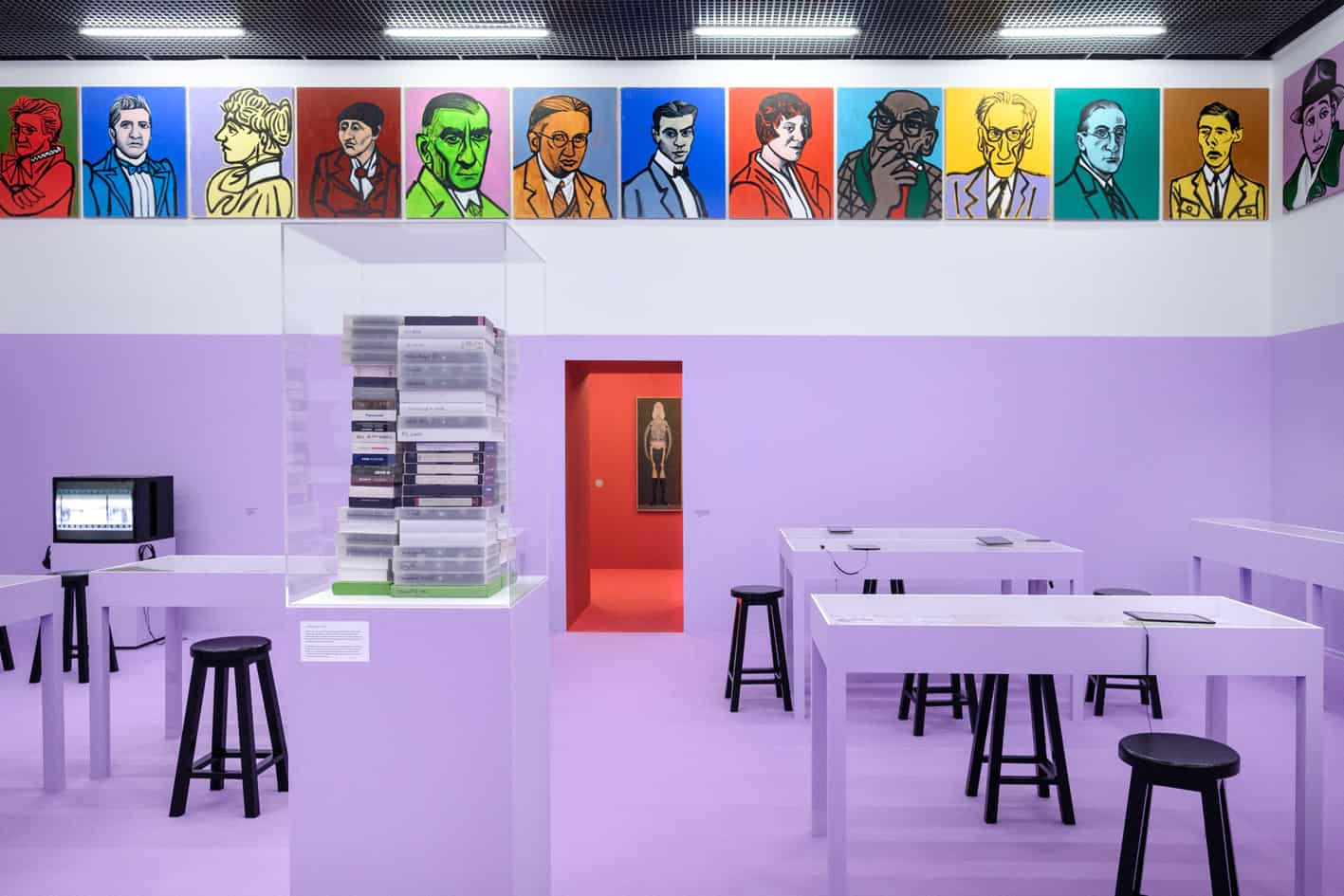
Karol Radziszewski, The Power of Secrets, exhibition view, 2020, photo by Bartosz Górka
MCz: The people you portray are known from history. You also invite other artists to participate in your exhibitions. How exactly do they contribute?
KR: This was my curator, Michał Grzegorzek’s idea to show my cooperation strategy. I cooperate with different artists a lot and invite them to joint activities. The artists I invited to make their contribution to this exhibition are my friends. They are very important to me both in terms of their work as artists and on a more personal level. I was thinking how they could potentially complement my works and bring to the exhibition their personal touch at the same time. This was supposed to be something that was not present in my own activities as an artist. Wolfgang Tillmans presents his installations featuring photos of Russia, a country I have never been to. In these we can see LGBT activists from Saint Petersburg. A Czech photographer, Libuša Jarcovjákova, presents photo series documenting the T-club, i.e. gay and lesbian club of Prague from the early 1980s. These photographs fit perfectly in the gap of the Polish narration i.e. lesbian visual culture. Me and Libuša have known each other for many years now. I used to publish her photos in DIK Fagazine. Then, there is also Ryszard Kisiel. His full archive was handed over to the “Queer Archives Institute” and thereby became the core of my archive. Hence, Ryszard’s presence at my exhibition can be felt in many different ways. He is featured in my “Afterimage” film. He took the photographs of meeting spots of gay community of the times as well. There is also a separate room where visitors can see works which had never been exhibited before i.e. photographs from the gay beaches in Sobieszewo, which date back to 1969 and 1971. These photos let us travel even further back in history, to the times before the 1980s. These were Arcadian Times, the era before AIDS. Natalia LL is another contributor. She is my friend and I already experienced working with her in the past. I used to reference her works and queer them. In the current project, she provides the part of narration about the queer beyond or ideas of what will come afterwards. Her work is presented right next to the AIDS room, i.e. the death room. Natalia’s work, however, serves another purpose as well. It provides a positive alternative and an insider’s look of a much older person who can imagine the queer beyond in a completely different way and present her ideas through art. The last contributor that was invited is the General Idea group, whose work adds to the Eastern European narration related to AIDS. Most artists I invited to cooperate with me on this exhibition was much older than me. They have completely different experiences and feel different emotions. This cooperation between representatives of different generations is important for me. When I worked as co-organizer of Pomada festival or when I published DIK Fagazine, numerous male and female artists were always invited to provide their input. We work together very often. Exchange is one of the crucial aspects of the “Queer Archives Institute”. I exchange works with other artists, it resembles the “Exchange Gallery” of Józef Robakowski a little bit. In this way the QAI collection is extended and develops in two directions – deep into history and forward.
MCz: What is the “Queer Archives Institute”?
KR: It is an umbrella. It provides a platform and a frame for all my activities. Here, I mean my collecting activities, that is my collecting works, materials, historical objects, and interviews or spoken history which I work with But I also mean works and interpretations of works which I created based on the archives and works by other artists created on the basis of protagonists or other stories from the past. Altogether these things combine into the “Queer Archives Institute”. I use the word ‘archives’ in plural because there are various archives, not only those which belong to me and not only Polish ones. The idea behind the archives is an extensive network which allows cooperation with other people living in various countries around the globe.
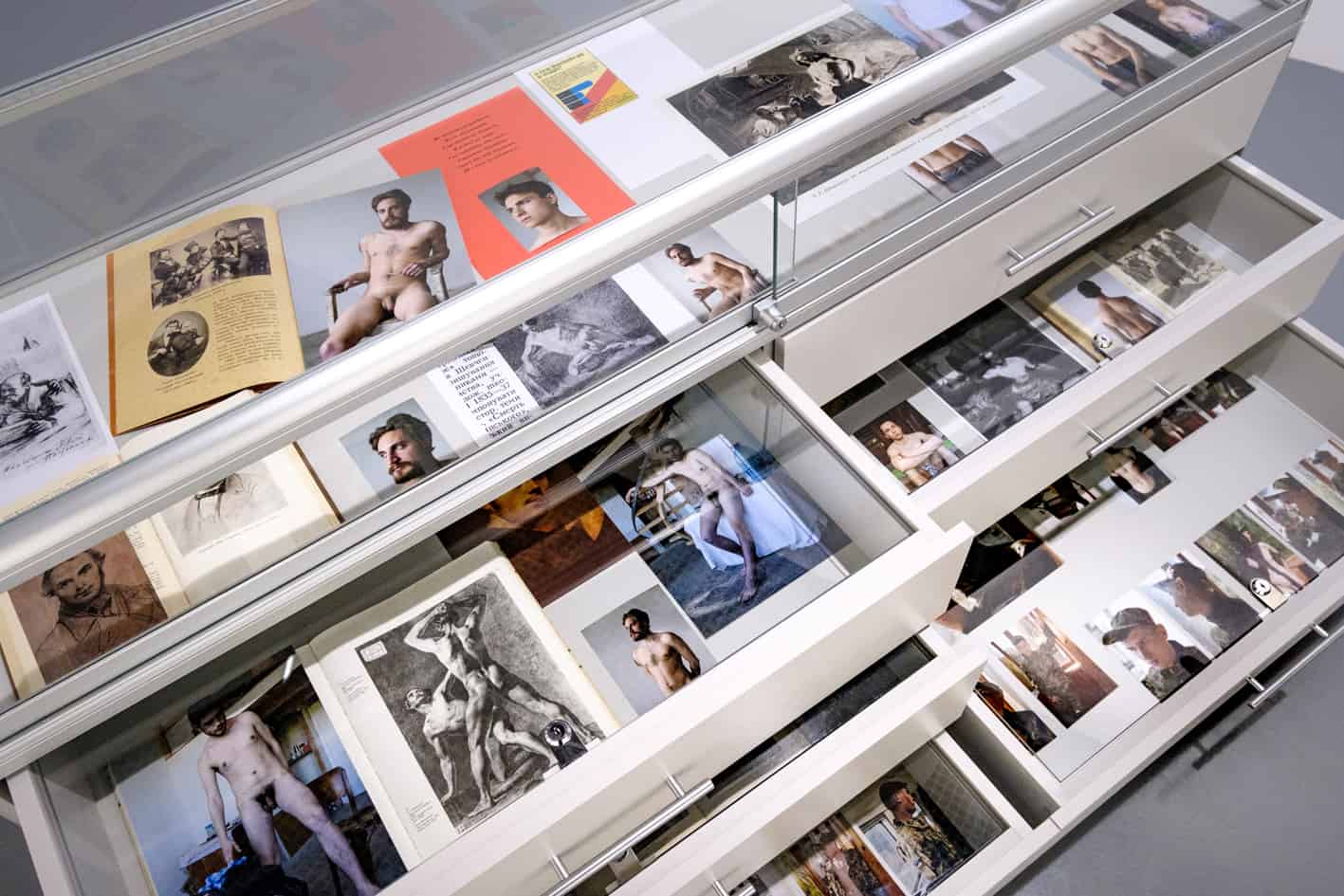
Karol Radziszewski, The Power of Secrets, exhibition view, 2020, photo by Bartosz Górka
MCz: What is the structure of the current exhibition?
KR: The whole project was supposed to be a retrospective, but the attempt to combine all of the works just produced chaos, thematic chaos too. While in terms of strategy and work all of it falls under the general concept of queer, the works, over the course of years, differered a lot. This was why I agreed to what Michał Grzegorzek proposed, namely, to focus on the performative aspect of the archives. The axis or the background to the exhibition is the metaphorical journey from birth to the moment of death. I consider this idea not to be overly blatant, but at the same time it seems to structure the journey I take my audience on. This is the journey from our childhood and the moment we understand that we do not necessarily have to be subject to norms, through various aspects of us maturing, struggling, becoming sick, cruising and having sex to the queer beyond.
MCz: You mainly show us your recent works and the archives. You mentioned this being your retrospective, so I was wondering whether we would see here any works from the exhibition held on this very same floor back in 2007.
KR: That exhibition was entitled I always wanted and its topic was identity. The main motives presented there were family, religion and homosexuality. The pieces revolved around these topics in the context of art. For example, the work “Jesus I Trust in You” was a direct reference to me being Catholic and to family as a broader concept. In those works one could see my grandmother knitting balaclavas that were later used by a gay gang. The background to what was presented was family and religion. This turned out to be the most challenging identity deadlock for me. What I present today stems from all the years I diligently worked through. I consciously gave up on references to religion and the current political situation contributed to this approach. At the same time, as QAI founder, I am obliged to present a broader perspective rather than focus solely on the perspective of homosexual men. This is supposed to be a platform where more divergent views can be represented. I try to assume the responsibility for it. Such stories have much greater impact and reach more communities. This is the very reason why I prefer staying behind and give the space out so that other narratives can be represented as well. I particularly welcome the stories by transgender people. I really wanted them to take part in my project maybe because I have never presented such a great number of them on a single occasion.

Karol Radziszewski, The Power of Secrets, exhibition view, 2020, photo by Bartosz Górka
MCz: You said that this exhibition is an educational project. So, what is it that you want to teach us?
KR: The first thing is to show a different perspective. I want to show everybody that history is like literature which can be interpreted in many ways. Those who write down history do it for someone else and they have the power to manipulate history or present an alternative version of it. I try to present my own version of events and distribute focal points differently. I tell stories from the point of view of minorities and forgotten communities and I get my message across thanks to exaggeration and drawing viewers’ attention to certain aspects. In this way my works become noticeable and the general public is aware of the issues I present. They thereby learn tolerance realize that not knowing something does not automatically mean that it did not exist but only that in order to know about it you need a little effort and research.
MCz: How can such stories teach tolerance?
KR: Every time we learn that history and society are much more complex and that there is no such thing as a single identity, it becomes more difficult for us to say things like: “there has never been a thing like that”, “they never existed” or “this came to us from the West”. And indeed, we can look at trans community and the whole “Solidarity” movement from a different perspective. The question of sexual identity intertwines smoothly with figures who were crucial in Polish history and the process of development of the Polish culture. My “Poczet” series clearly shows that.
MCz: How did you structure this painting series?
KR: I arranged the pictures in chronological order, just like Matejko. The order is based on the dates of birth of the portrayed figures. They are all heroes for the general public. I did not intend to present the results of any niche research, but rather to show aspects of well-known history that had not been brought to light beforehand. Kings, writers and people we read about in every history book. We seemingly know them so well, but there are minor aspects of their biographies which had been overlooked. I put these aspects at the core, even just by juxtaposing these figures together. This community can be organized in a totally different way.
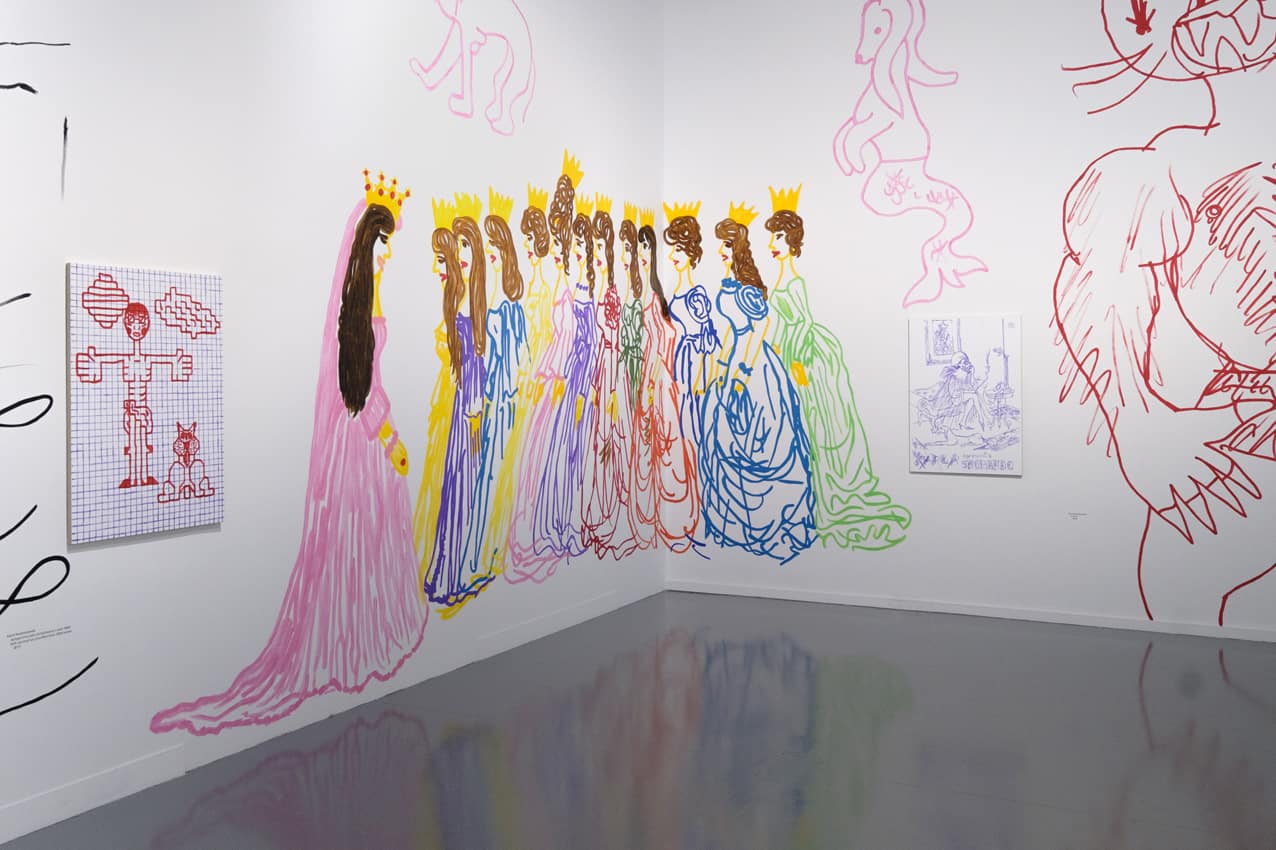
Karol Radziszewski, The Power of Secrets, exhibition view, 2020, photo by Bartosz Górka
MCz: There have been complaints that you should not have elaborated on topics which do not concern you directly. Topics such as AIDS.
KR: At the exhibition I present original archival materials on HIV and AIDS, which are part of our common history. This is one of the key elements of LGBT background and identity. As I said before, I give visibility to others by offering them the necessary space. I present the wallpaper inspired by the collage by Ryszard Kisiel from 1989 and iconic works by General Idea group. My exhibition is the first occasion when works by General Idea are presented in Poland. In 2006 I created a work about my first HIV test. That was a very personal work sharing my own experience and communicating the message solely on my behalf.
MCz: The most astonishing work you present is a mushroom. This is neither a painting nor a piece from your archives.
KR: I created a metal sculpture for the very first time. This resulted from the strategy I adopted. Depending on the topic I use different media and make references to works by different artists. I queered Krasiński’s blue line by changing its colour to pink and I re-performed “Dreaming” by Natalia LL. “Mushroom” refers to aesthetics used by Monika Sosnowska. This is the vehicle I use to tell about another obscure aspect of history. Affection and nostalgia for socialist modernist elements of architecture, and reflection on gentrification that wipes such architecture out, which Monika expresses in her works, helped me formulate my question. I asked whether a public toilet facility, which was so important for gay community during the communist era and which had been there for so long that legends had been told about it, should be commemorated. By means of this work I also suggest how a potential queer monument could function.
MCz: Could you define the notion of queering?
KR: It is like looking from the side and getting a glimpse of something from the perspective that others are not aware of, or do not want to acknowledge. This may be about an alternative sexual orientation or an alternative history of events. Queering is a vehicle to recover the potential subversive meanings which are present in the mainstream, for example, in the works by heterosexual artists. It is about turning the meanings which were important for such artists inside out, seeing them from a different angle and in that way, giving them a totally new meaning. Queering is also about reminding others about the aspects of history which do not have any visual representation, such as the life of Ewa Holuszko and the story of Operation Hyacinth.

Karol Radziszewski, The Power of Secrets, exhibition view, 2020, photo by Bartosz Górka
MCz: It is said that your exhibition will close on 2 January.
KR: We do not know what will happen and it is hard to say anything certain. I do not want to make any speculations as various scenarios are possible.
MCz: What are your wishes to the Ujazdowski Castle where you spent the last few months?
KR: I have cooperated with the Ujazdowski Castle for many years. I know many employees who have been here when I started working with this institution, i.e. in 2003, and continue working here today. I wish that the Ujazdowski Castle develops and broadens its horizons instead of limiting them. Potentially my exhibition won’t close on 2 January, but this institution will certainly change under the new management. It is regrettable that we are losing this oeuvre.
M.Cz.: Thank you for the conversation.
This article was first published in Polish on Miej Miejsce website.
Written by Marta Czyż
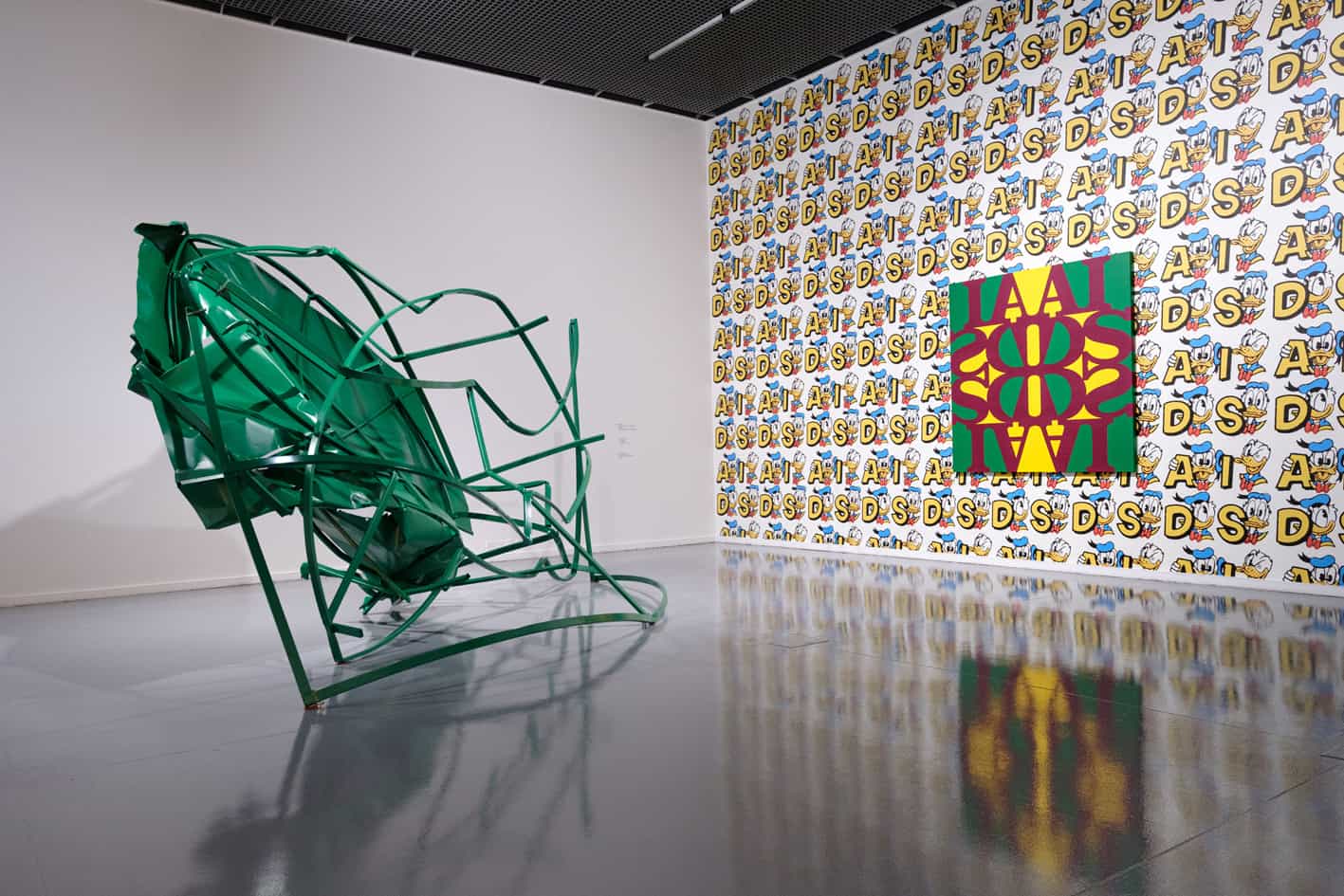
Karol Radziszewski, The Power of Secrets, exhibition view, 2020, photo by Bartosz Górka
Karol Radziszewski (born in 1980) works with film, photography, installations and creates interdisciplinary projects. He graduated from the Academy of Fine Arts in Warsaw where he studied at the Faculty of Painting. He is the publisher and editor-in-chief of DIK Fagazine and the founder of the Queer Archives Institute. He received the Paszport Polityki award in 2009.
His works have been shown in institutions such as Zachęta National Gallery, Museum of Modern Art in Warsaw, Muzeum Sztuki in Łódź, Wrocław Contemporary Museum, National Museum in Warsaw, the Ujazdowski Castle Centre for Contemporary Art, Kunsthalle Wien, New Museum in New York, Whitechapel Gallery in London, VideoBrasil in Sao Paulo, Cobra Museum in Amsterdam, as well as during PERFORMA 13. biennial in New York, 7th Göteborg Biennal, 4th Prague Biennal, New York Photo Festival and 15th WRO Media Art Biennal.
Marta Czyż – art historian, curator and author of texts about contemporary art. She curated exhibitions at Kordegarda gallery, BWA Zielona Góra and the Ujazdowski Castle Centre for Contemporary Art. She is the author of “D.O.M. Polski” (together with Julia Wielgus), which was published in cooperation with Raster gallery and BWA Zielona Góra, and “W ramach wystawy – rozmowy z kuratorami”, listed by culture.pl among ten most important books about art in 2015. She is currently working on a publication presenting an analysis of the most important exhibitions in the history of Polish art, which will be financed from the grant she received from the Ministry of Culture and National Heritage.
Karol Radziszewski,
The Power of Secrets,
Ujazdowski Castle Centre for Contemporary Art,
15/11/2019–29/03/2020
Karol Radziszewski, The Power of Secrets, exhibition view, 2020, photo by Bartosz Górka



